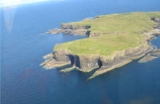
Staffa
Encyclopedia
Staffa from the Old Norse
for stave or pillar island, is an island of the Inner Hebrides
in Argyll and Bute
, Scotland
. The Vikings gave it this name as its columnar basalt
reminded them of their houses, which were built from vertically placed tree-logs.
Staffa lies about 10 kilometres (6.2 mi) west of the Isle of Mull
. The area is 33 hectare (0.127413712335537 sq mi) and the highest point is 42 metres (138 ft) above sea level
.
The island came to prominence in the late 18th century after a visit by Sir Joseph Banks. He and his fellow travellers extolled the natural beauty of the basalt columns in general and of the island's main sea cavern which Banks re-named 'Fingal's Cave
'. Their visit was followed by that of many other prominent personalities throughout the next two centuries, including Queen Victoria and Felix Mendelssohn
. The latter's Hebrides Overture
brought further fame to the island, which was by then uninhabited. It is now in the care of the National Trust for Scotland
.
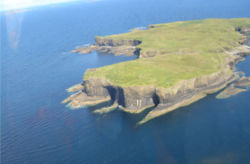 In pre-historic times Staffa was covered by the ice sheets which spread from Scotland out into the Atlantic Ocean
In pre-historic times Staffa was covered by the ice sheets which spread from Scotland out into the Atlantic Ocean
beyond the Outer Hebrides
. After the last retreat of the ice around 20,000 years ago, sea levels were up to 125 metres (410 ft) lower than at present. Although the isostatic
rise of land makes estimating post-glacial coastlines a complex task, c. 14,000 BP
it is likely that Staffa was a larger island, just off the coast of mainland Scotland, which at that time would have included what is now the Isle of Mull
, Iona
and the Treshnish Isles
.
Steadily rising sea levels since that time then further isolated this little island, which is entirely of volcanic
origin. It consists of a basement of tuff
, underneath colonnades of a black fine-grained Tertiary
basalt
, overlying which is a third layer of basaltic lava lacking a crystalline structure. By contrast, slow cooling of the second layer of basalt resulted in an extraordinary pattern of predominantly hexagonal columns which form the faces and walls of the principal caves. The lava contracted towards each of a series of equally spaced centres as it cooled and solidified into prismatic columns, a process known as columnar jointing. The columns typically have three to eight sides, six being most common. The columns are also divided horizontally by cross joints. Similar formations are found at the Giant's Causeway
in Northern Ireland
, on the island of Ulva
and Ardmeanach on the Isle of Mull
. Grooves in the roof of MacKinnon's cave indicate either a pyroclastic flow or a series of eroded ash falls in the rock above the columnar basalt. The 'Staffa Group' is the name given to the series of olivine
tholeiite basalts found in the vicinity of Mull
which erupted 55–58 million years ago.
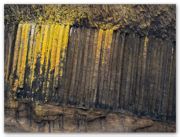 Staffa lies about 10 kilometres (6 mi) west of Mull
Staffa lies about 10 kilometres (6 mi) west of Mull
, and 9 km northeast of Iona
. It is longitudinally oriented north-south, and is a kilometre long by about half a kilometre wide. The circumference is about 3.8 km in extent. In the northeast the isle shelves to a shore, but otherwise the coast is rugged and much indented, numerous caves having been carved out by rain, stream and ocean. There is enough grass on the surface to feed a few cattle, and the island contains a spring.
On the east coast are Goat Cave and Clamshell Cave. The latter is 10 m high, about 6 m wide at the entrance, some 45 m long, and on one side of it the ridges of basalt stand out like the ribs of a ship. Near this cave is the pyramidal rock islet of Am Buachaille ('The Herdsman'), a pile of basalt columns fully seen only at low tide. Other outlying rocks include Eilean Dubh to the north-west and a series of skerries stretching for half a kilometre to the south-west. On the southwest shore are Boat Cave and Mackinnon’s Cave (named after an 15th-century abbot of Iona
), which has a tunnel connecting it to Cormorant Cave. These caves lie to the south-west and can be accessed from the bay of Port an Fhasgaidh at low tide. In 1945 a mine exploded near Boat Cave causing damage to the cliff face which is still visible. At 107 metres, Mackinnon's Cave is the 79th longest sea cave in the world.
Staffa's most famous feature is Fingal's Cave
, a large sea cave located near the southern tip of the island some 20 m high and 75 m long formed in cliffs of hexagonal basalt
columns. This cliff-face is called the Colonnade or The Great Face and it was these cliffs and its caves that inspired Felix Mendelssohn
's Die Hebriden (English: Hebrides Overture
opus 26), which was premiered in London
in 1832. The original gaelic name for Fingal's Cave is An Uamh Bhin – "the melodious cave" – but it was subsequently renamed after the 3rd-century Irish warrior Fionn MacCool
. Mendelssohn was nonetheless inspired by the sound of the waves in the cave and waxed lyrical about his visit, claiming that he arrived in Scotland: "with a rake for folk-songs, an ear for the lovely, fragrant countryside, and a heart for the bare legs of the natives."
Staffa is part of the Loch Na Keal
National Scenic Area
, one of 40 in Scotland.
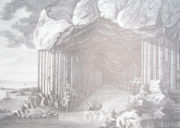
town of Stäfa
on Lake Zurich
was named after the island by a monk from nearby Iona
. Originally part of the Ulva
estate of the MacQuarries
until 1777, it was brought to the English-speaking world's attention after a visit by Sir Joseph Banks in August 1772. En route to Iceland
in the company of the painter Johann Zoffany
, the Bishop of Linköping
, and a Dr. Solander, Banks, (later a president of the Royal Society
) was entertained by Maclean of Drummen, on the Isle of Mull
. Hearing about Staffa he resolved to visit and set out from Tobermory the next day. The winds were light and they did not arrive until darkness had fallen. Banks wrote:
They were not disappointed. Despite becoming infested with lice during his short stay on the island, he provided glowing reports of his visit. He confessed that he was:
Samuel Johnson
and his protege James Boswell
visited The MacQuarrie on Ulva in 1773, the year after Banks' visit. Perhaps aware that Banks considered that the columnar basalt cliff formations on Ulva called "The Castles" rivalled Staffa's Johnson wrote:
Amongst the first eminent overseas visitors to Staffa were Barthélemy Faujas de Saint-Fond
, a wealthy French zoologist and mineralogist and the American architect and naturalist William Thornton
. Visiting in 1784, they were suitably impressed, Faujus writing: "this superb monument of nature, which in regard to its form bears so strong a resemblance to a work of art, though art can certainly claim no share in it."
, Sir Walter Scott (1810), John Keats
(1818), J. M. W. Turner
, whose 1830 visit yielded an oil painting exhibited in 1832, William Wordsworth
(1833), Jules Verne
(1839), Alice Liddell
(the inspiration for Alice in Wonderland
) in 1878, David Livingstone
(1864), Robert Louis Stevenson
(1870) and Mendelssohn himself in 1829. Wordsworth, however, found the volume of tourism disappointing.
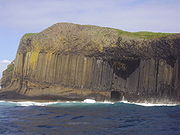
Writing more than a century later the writer W. H. Murray agreed, complaining that the visitors spoiled the "character and atmosphere", and rather stand-offishly suggesting that "to know Staffa one must go alone".
Others were more enthusiastic, despite the presence of numerous others. Queen Victoria and Prince Albert were rowed into the cave in the royal barge in 1847, and The Times correspondent recorded:
 Keats complained about the expense of the ferry, but was captivated by what he saw nonetheless. Displeased with his first efforts to describe this "cathedral of the sea" he finally settled on:
Keats complained about the expense of the ferry, but was captivated by what he saw nonetheless. Displeased with his first efforts to describe this "cathedral of the sea" he finally settled on:
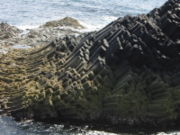 However inspiring the scenery, it was not an easy place to live. In 1772 there was but a single family living on a diet of barley oats, flax and potatoes, and whatever their grazing animals could provide. By the end of the 18th century they had deserted Staffa, apparently terrified by the severity of winter storms. Signs of "rig and furrow" agriculture can still be seen on the island but the only surviving building is the ruin of a 19th century shelter for travellers. By 1800 the island was under the ownership of Colin MacDonald of Loch Boisdale
However inspiring the scenery, it was not an easy place to live. In 1772 there was but a single family living on a diet of barley oats, flax and potatoes, and whatever their grazing animals could provide. By the end of the 18th century they had deserted Staffa, apparently terrified by the severity of winter storms. Signs of "rig and furrow" agriculture can still be seen on the island but the only surviving building is the ruin of a 19th century shelter for travellers. By 1800 the island was under the ownership of Colin MacDonald of Loch Boisdale
. In 1816 it was sold by his son Ranald MacDonald into the care of Trustees. In 1821 these Trustees sold to Alexander Forman as Trustee, the purchase money being paid by his brother John Forman WS. It remained in the Forman family until sold by Bernard Gilpin Vincent "Pat" Forman in 1968. There were several private owners after that, including Alastair de Watteville, a descendant of Colin MacDonald who wrote a book about the island, until finally it was gifted to the National Trust for Scotland
by Jock Elliot Jr. of New York in 1986 as an imaginative way to honour the 60th birthday of his wife, Eleanor. A grateful National Trust bestowed upon her the honorific "Steward of Staffa". In a 2005 poll
of Radio Times
readers, Staffa was named as the 8th greatest natural wonder in Britain.
During the 20th century there have been issues of bogus postage stamps
bearing Staffa's name.
 In 1800 there were three Red Deer
In 1800 there were three Red Deer
on the island, later replaced by goats and then a small herd of black cattle. Subsequently the summer grazing was used for sheep by crofters from Iona but in 1997 all livestock was removed. This has led to a regeneration of the island's vegetation.
Puffin
, Black-legged Kittiwake
s, Common Shag
and gull
s nest on the island and the surrounding waters provide a livelihood for numerous seabirds, Gray Seals, dolphin
s, Basking Shark
s, Minke
, and Pilot Whale
s.
, Dervaig on Mull, Fionnphort
and Iona
allow visitors to view caves and the puffins that nest on the island between May and September.
There is a landing place used by the tourist boats just north of Am Buachaille, but disembarkation is only possible in calm conditions. The island lacks a genuine anchorage.
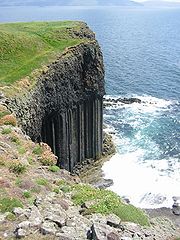
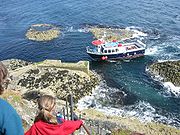

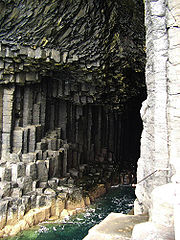
Old Norse
Old Norse is a North Germanic language that was spoken by inhabitants of Scandinavia and inhabitants of their overseas settlements during the Viking Age, until about 1300....
for stave or pillar island, is an island of the Inner Hebrides
Inner Hebrides
The Inner Hebrides is an archipelago off the west coast of Scotland, to the south east of the Outer Hebrides. Together these two island chains form the Hebrides, which enjoy a mild oceanic climate. There are 36 inhabited islands and a further 43 uninhabited Inner Hebrides with an area greater than...
in Argyll and Bute
Argyll and Bute
Argyll and Bute is both one of 32 unitary council areas; and a Lieutenancy area in Scotland. The administrative centre for the council area is located in Lochgilphead.Argyll and Bute covers the second largest administrative area of any Scottish council...
, Scotland
Scotland
Scotland is a country that is part of the United Kingdom. Occupying the northern third of the island of Great Britain, it shares a border with England to the south and is bounded by the North Sea to the east, the Atlantic Ocean to the north and west, and the North Channel and Irish Sea to the...
. The Vikings gave it this name as its columnar basalt
Basalt
Basalt is a common extrusive volcanic rock. It is usually grey to black and fine-grained due to rapid cooling of lava at the surface of a planet. It may be porphyritic containing larger crystals in a fine matrix, or vesicular, or frothy scoria. Unweathered basalt is black or grey...
reminded them of their houses, which were built from vertically placed tree-logs.
Staffa lies about 10 kilometres (6.2 mi) west of the Isle of Mull
Isle of Mull
The Isle of Mull or simply Mull is the second largest island of the Inner Hebrides, off the west coast of Scotland in the council area of Argyll and Bute....
. The area is 33 hectare (0.127413712335537 sq mi) and the highest point is 42 metres (138 ft) above sea level
Sea level
Mean sea level is a measure of the average height of the ocean's surface ; used as a standard in reckoning land elevation...
.
The island came to prominence in the late 18th century after a visit by Sir Joseph Banks. He and his fellow travellers extolled the natural beauty of the basalt columns in general and of the island's main sea cavern which Banks re-named 'Fingal's Cave
Fingal's Cave
Fingal's Cave is a sea cave on the uninhabited island of Staffa, in the Inner Hebrides of Scotland, part of a National Nature Reserve owned by the National Trust for Scotland. It is formed entirely from hexagonally jointed basalt columns, similar in structure to the Giant's Causeway in Northern...
'. Their visit was followed by that of many other prominent personalities throughout the next two centuries, including Queen Victoria and Felix Mendelssohn
Felix Mendelssohn
Jakob Ludwig Felix Mendelssohn Barthóldy , use the form 'Mendelssohn' and not 'Mendelssohn Bartholdy'. The Grove Dictionary of Music and Musicians gives ' Felix Mendelssohn' as the entry, with 'Mendelssohn' used in the body text...
. The latter's Hebrides Overture
Hebrides Overture
The Hebrides Overture , Op. 26, also known as Fingal's Cave , is a concert overture composed by Felix Mendelssohn. Written in 1830, the piece was inspired by a cavern known as Fingal's Cave on Staffa, an island in the Hebrides archipelago located off the west coast of Scotland...
brought further fame to the island, which was by then uninhabited. It is now in the care of the National Trust for Scotland
National Trust for Scotland
The National Trust for Scotland for Places of Historic Interest or Natural Beauty, commonly known as the National Trust for Scotland describes itself as the conservation charity that protects and promotes Scotland's natural and cultural heritage for present and future generations to...
.
Geology and pre-history

Atlantic Ocean
The Atlantic Ocean is the second-largest of the world's oceanic divisions. With a total area of about , it covers approximately 20% of the Earth's surface and about 26% of its water surface area...
beyond the Outer Hebrides
Outer Hebrides
The Outer Hebrides also known as the Western Isles and the Long Island, is an island chain off the west coast of Scotland. The islands are geographically contiguous with Comhairle nan Eilean Siar, one of the 32 unitary council areas of Scotland...
. After the last retreat of the ice around 20,000 years ago, sea levels were up to 125 metres (410 ft) lower than at present. Although the isostatic
Isostasy
Isostasy is a term used in geology to refer to the state of gravitational equilibrium between the earth's lithosphere and asthenosphere such that the tectonic plates "float" at an elevation which depends on their thickness and density. This concept is invoked to explain how different topographic...
rise of land makes estimating post-glacial coastlines a complex task, c. 14,000 BP
Before Present
Before Present years is a time scale used in archaeology, geology, and other scientific disciplines to specify when events in the past occurred. Because the "present" time changes, standard practice is to use AD 1950 as the origin of the age scale, reflecting the fact that radiocarbon...
it is likely that Staffa was a larger island, just off the coast of mainland Scotland, which at that time would have included what is now the Isle of Mull
Isle of Mull
The Isle of Mull or simply Mull is the second largest island of the Inner Hebrides, off the west coast of Scotland in the council area of Argyll and Bute....
, Iona
Iona
Iona is a small island in the Inner Hebrides off the western coast of Scotland. It was a centre of Irish monasticism for four centuries and is today renowned for its tranquility and natural beauty. It is a popular tourist destination and a place for retreats...
and the Treshnish Isles
Treshnish Isles
The Treshnish Isles is an archipelago of small islands and skerries, lying west of Mull, in Scotland. They are part of the Inner Hebrides. From north to south, the larger islands include:* Cairn na Burgh Beag* Cairn na Burgh Mòr* Fladda...
.
Steadily rising sea levels since that time then further isolated this little island, which is entirely of volcanic
Vulcanism
Vulcanism may refer to* Volcanism or volcanic activity.* Plutonism, a scientific theory of the Earth....
origin. It consists of a basement of tuff
Tuff
Tuff is a type of rock consisting of consolidated volcanic ash ejected from vents during a volcanic eruption. Tuff is sometimes called tufa, particularly when used as construction material, although tufa also refers to a quite different rock. Rock that contains greater than 50% tuff is considered...
, underneath colonnades of a black fine-grained Tertiary
Tertiary
The Tertiary is a deprecated term for a geologic period 65 million to 2.6 million years ago. The Tertiary covered the time span between the superseded Secondary period and the Quaternary...
basalt
Basalt
Basalt is a common extrusive volcanic rock. It is usually grey to black and fine-grained due to rapid cooling of lava at the surface of a planet. It may be porphyritic containing larger crystals in a fine matrix, or vesicular, or frothy scoria. Unweathered basalt is black or grey...
, overlying which is a third layer of basaltic lava lacking a crystalline structure. By contrast, slow cooling of the second layer of basalt resulted in an extraordinary pattern of predominantly hexagonal columns which form the faces and walls of the principal caves. The lava contracted towards each of a series of equally spaced centres as it cooled and solidified into prismatic columns, a process known as columnar jointing. The columns typically have three to eight sides, six being most common. The columns are also divided horizontally by cross joints. Similar formations are found at the Giant's Causeway
Giant's Causeway
The Giant's Causeway is an area of about 40,000 interlocking basalt columns, the result of an ancient volcanic eruption. It is located in County Antrim on the northeast coast of Northern Ireland, about three miles northeast of the town of Bushmills...
in Northern Ireland
Northern Ireland
Northern Ireland is one of the four countries of the United Kingdom. Situated in the north-east of the island of Ireland, it shares a border with the Republic of Ireland to the south and west...
, on the island of Ulva
Ulva
Ulva is an island in the Inner Hebrides of Scotland, off the west coast of Mull. It is separated from Mull by a narrow strait, and connected to the neighbouring island of Gometra by a bridge. Much of the island is formed from Tertiary basalt rocks, which is formed into columns in places.Ulva has...
and Ardmeanach on the Isle of Mull
Isle of Mull
The Isle of Mull or simply Mull is the second largest island of the Inner Hebrides, off the west coast of Scotland in the council area of Argyll and Bute....
. Grooves in the roof of MacKinnon's cave indicate either a pyroclastic flow or a series of eroded ash falls in the rock above the columnar basalt. The 'Staffa Group' is the name given to the series of olivine
Olivine
The mineral olivine is a magnesium iron silicate with the formula 2SiO4. It is a common mineral in the Earth's subsurface but weathers quickly on the surface....
tholeiite basalts found in the vicinity of Mull
Isle of Mull
The Isle of Mull or simply Mull is the second largest island of the Inner Hebrides, off the west coast of Scotland in the council area of Argyll and Bute....
which erupted 55–58 million years ago.
Geography

Isle of Mull
The Isle of Mull or simply Mull is the second largest island of the Inner Hebrides, off the west coast of Scotland in the council area of Argyll and Bute....
, and 9 km northeast of Iona
Iona
Iona is a small island in the Inner Hebrides off the western coast of Scotland. It was a centre of Irish monasticism for four centuries and is today renowned for its tranquility and natural beauty. It is a popular tourist destination and a place for retreats...
. It is longitudinally oriented north-south, and is a kilometre long by about half a kilometre wide. The circumference is about 3.8 km in extent. In the northeast the isle shelves to a shore, but otherwise the coast is rugged and much indented, numerous caves having been carved out by rain, stream and ocean. There is enough grass on the surface to feed a few cattle, and the island contains a spring.
On the east coast are Goat Cave and Clamshell Cave. The latter is 10 m high, about 6 m wide at the entrance, some 45 m long, and on one side of it the ridges of basalt stand out like the ribs of a ship. Near this cave is the pyramidal rock islet of Am Buachaille ('The Herdsman'), a pile of basalt columns fully seen only at low tide. Other outlying rocks include Eilean Dubh to the north-west and a series of skerries stretching for half a kilometre to the south-west. On the southwest shore are Boat Cave and Mackinnon’s Cave (named after an 15th-century abbot of Iona
Iona
Iona is a small island in the Inner Hebrides off the western coast of Scotland. It was a centre of Irish monasticism for four centuries and is today renowned for its tranquility and natural beauty. It is a popular tourist destination and a place for retreats...
), which has a tunnel connecting it to Cormorant Cave. These caves lie to the south-west and can be accessed from the bay of Port an Fhasgaidh at low tide. In 1945 a mine exploded near Boat Cave causing damage to the cliff face which is still visible. At 107 metres, Mackinnon's Cave is the 79th longest sea cave in the world.
Staffa's most famous feature is Fingal's Cave
Fingal's Cave
Fingal's Cave is a sea cave on the uninhabited island of Staffa, in the Inner Hebrides of Scotland, part of a National Nature Reserve owned by the National Trust for Scotland. It is formed entirely from hexagonally jointed basalt columns, similar in structure to the Giant's Causeway in Northern...
, a large sea cave located near the southern tip of the island some 20 m high and 75 m long formed in cliffs of hexagonal basalt
Basalt
Basalt is a common extrusive volcanic rock. It is usually grey to black and fine-grained due to rapid cooling of lava at the surface of a planet. It may be porphyritic containing larger crystals in a fine matrix, or vesicular, or frothy scoria. Unweathered basalt is black or grey...
columns. This cliff-face is called the Colonnade or The Great Face and it was these cliffs and its caves that inspired Felix Mendelssohn
Felix Mendelssohn
Jakob Ludwig Felix Mendelssohn Barthóldy , use the form 'Mendelssohn' and not 'Mendelssohn Bartholdy'. The Grove Dictionary of Music and Musicians gives ' Felix Mendelssohn' as the entry, with 'Mendelssohn' used in the body text...
's Die Hebriden (English: Hebrides Overture
Hebrides Overture
The Hebrides Overture , Op. 26, also known as Fingal's Cave , is a concert overture composed by Felix Mendelssohn. Written in 1830, the piece was inspired by a cavern known as Fingal's Cave on Staffa, an island in the Hebrides archipelago located off the west coast of Scotland...
opus 26), which was premiered in London
London
London is the capital city of :England and the :United Kingdom, the largest metropolitan area in the United Kingdom, and the largest urban zone in the European Union by most measures. Located on the River Thames, London has been a major settlement for two millennia, its history going back to its...
in 1832. The original gaelic name for Fingal's Cave is An Uamh Bhin – "the melodious cave" – but it was subsequently renamed after the 3rd-century Irish warrior Fionn MacCool
Fionn mac Cumhaill
Fionn mac Cumhaill , known in English as Finn McCool, was a mythical hunter-warrior of Irish mythology, occurring also in the mythologies of Scotland and the Isle of Man...
. Mendelssohn was nonetheless inspired by the sound of the waves in the cave and waxed lyrical about his visit, claiming that he arrived in Scotland: "with a rake for folk-songs, an ear for the lovely, fragrant countryside, and a heart for the bare legs of the natives."
Staffa is part of the Loch Na Keal
Loch Na Keal
Loch Na Keal , meaning Loch of the Kyle, or Narrows, also Loch of the Cliffs, is the principle sea loch on the western, or Atlantic coastline of the island of Mull, in the Inner Hebrides, Argyll and Bute, Scotland...
National Scenic Area
National Scenic Area
National Scenic Area is a designation for areas of natural beauty used by more than one nation.* National Scenic Area * National Scenic Area * National scenic areas in Taiwan* National Scenic Area...
, one of 40 in Scotland.
History

18th century
Little is known of the early history of Staffa, although the SwissSwitzerland
Switzerland name of one of the Swiss cantons. ; ; ; or ), in its full name the Swiss Confederation , is a federal republic consisting of 26 cantons, with Bern as the seat of the federal authorities. The country is situated in Western Europe,Or Central Europe depending on the definition....
town of Stäfa
Stäfa
Stäfa is a municipality in the district of Meilen in the canton of Zürich in Switzerland.-Geography:Stäfa has an area of . Of this area, 46.1% is used for agricultural purposes, while 18.8% is forested. Of the rest of the land, 34% is settled and the remainder is non-productive...
on Lake Zurich
Lake Zurich
Lake Zurich is a lake in Switzerland, extending southeast of the city of Zurich. It is also known as Lake Zürich and Lake of Zürich. It lies approximately at co-ordinates ....
was named after the island by a monk from nearby Iona
Iona
Iona is a small island in the Inner Hebrides off the western coast of Scotland. It was a centre of Irish monasticism for four centuries and is today renowned for its tranquility and natural beauty. It is a popular tourist destination and a place for retreats...
. Originally part of the Ulva
Ulva
Ulva is an island in the Inner Hebrides of Scotland, off the west coast of Mull. It is separated from Mull by a narrow strait, and connected to the neighbouring island of Gometra by a bridge. Much of the island is formed from Tertiary basalt rocks, which is formed into columns in places.Ulva has...
estate of the MacQuarries
Clan MacQuarrie
Clan MacQuarrie is a Highland Scottish clan, associated with the islands of Ulva, Staffa and the Isle of Mull, which are all located in the Scottish Inner Hebrides. The last chief of Clan MacQuarrie died in 1818 and since the clan does not have a current Chief recognized by Lord Lyon it can be...
until 1777, it was brought to the English-speaking world's attention after a visit by Sir Joseph Banks in August 1772. En route to Iceland
Iceland
Iceland , described as the Republic of Iceland, is a Nordic and European island country in the North Atlantic Ocean, on the Mid-Atlantic Ridge. Iceland also refers to the main island of the country, which contains almost all the population and almost all the land area. The country has a population...
in the company of the painter Johann Zoffany
Johann Zoffany
Johan Zoffany, Zoffani or Zauffelij was a German neoclassical painter, active mainly in England...
, the Bishop of Linköping
Linköping
Linköping is a city in southern middle Sweden, with 104 232 inhabitants in 2010. It is the seat of Linköping Municipality with 146 736 inhabitants and the capital of Östergötland County...
, and a Dr. Solander, Banks, (later a president of the Royal Society
Royal Society
The Royal Society of London for Improving Natural Knowledge, known simply as the Royal Society, is a learned society for science, and is possibly the oldest such society in existence. Founded in November 1660, it was granted a Royal Charter by King Charles II as the "Royal Society of London"...
) was entertained by Maclean of Drummen, on the Isle of Mull
Isle of Mull
The Isle of Mull or simply Mull is the second largest island of the Inner Hebrides, off the west coast of Scotland in the council area of Argyll and Bute....
. Hearing about Staffa he resolved to visit and set out from Tobermory the next day. The winds were light and they did not arrive until darkness had fallen. Banks wrote:
It was too dark to see anything, so we carried our tent and baggage near the only house on the island, and began to cook our suppers, in order to be prepared for the earliest dawn, and to enjoy that which, from the conversation of the gentlemen we had, now raised the highest expectations of.
They were not disappointed. Despite becoming infested with lice during his short stay on the island, he provided glowing reports of his visit. He confessed that he was:
forced to acknowledge that this piece of architecture, formed by nature, far surpasses that of the LouvreLouvreThe Musée du Louvre – in English, the Louvre Museum or simply the Louvre – is one of the world's largest museums, the most visited art museum in the world and a historic monument. A central landmark of Paris, it is located on the Right Bank of the Seine in the 1st arrondissement...
, that of St. PeterSt. Peter's BasilicaThe Papal Basilica of Saint Peter , officially known in Italian as ' and commonly known as Saint Peter's Basilica, is a Late Renaissance church located within the Vatican City. Saint Peter's Basilica has the largest interior of any Christian church in the world...
at Rome, all that remains of PalmyraPalmyraPalmyra was an ancient city in Syria. In the age of antiquity, it was an important city of central Syria, located in an oasis 215 km northeast of Damascus and 180 km southwest of the Euphrates at Deir ez-Zor. It had long been a vital caravan city for travellers crossing the Syrian desert...
and PaestumPaestumPaestum is the classical Roman name of a major Graeco-Roman city in the Campania region of Italy. It is located in the north of Cilento, near the coast about 85 km SE of Naples in the province of Salerno, and belongs to the commune of Capaccio, officially also named...
, and all that the genius, the taste and the luxury of the Greeks were capable of inventing.
Samuel Johnson
Samuel Johnson
Samuel Johnson , often referred to as Dr. Johnson, was an English author who made lasting contributions to English literature as a poet, essayist, moralist, literary critic, biographer, editor and lexicographer...
and his protege James Boswell
James Boswell
James Boswell, 9th Laird of Auchinleck was a lawyer, diarist, and author born in Edinburgh, Scotland; he is best known for the biography he wrote of one of his contemporaries, the English literary figure Samuel Johnson....
visited The MacQuarrie on Ulva in 1773, the year after Banks' visit. Perhaps aware that Banks considered that the columnar basalt cliff formations on Ulva called "The Castles" rivalled Staffa's Johnson wrote:
When the islanders were reproached with their ignorance or insensibility of the wonders of Staffa, they had not much to reply. They had indeed considered it little, because they had always seen it; and none but philosophers, nor they always, are struck with wonder otherwise than by novelty.
Amongst the first eminent overseas visitors to Staffa were Barthélemy Faujas de Saint-Fond
Barthélemy Faujas de Saint-Fond
Barthélemy Faujas de Saint-Fond , French geologist and traveller, was born at Montélimar. He was educated at the Jesuit's College at Lyon; afterwards he went to Grenoble where he studied law and was admitted as an advocate to the parlement.He rose to be president of the seneschal's court in...
, a wealthy French zoologist and mineralogist and the American architect and naturalist William Thornton
William Thornton
Dr. William Thornton was a British-American physician, inventor, painter and architect who designed the United States Capitol, an authentic polymath...
. Visiting in 1784, they were suitably impressed, Faujus writing: "this superb monument of nature, which in regard to its form bears so strong a resemblance to a work of art, though art can certainly claim no share in it."
19th and 20th centuries
Subsequently a stream of famous visitors came to view Staffa's wonders including Robert AdamRobert Adam
Robert Adam was a Scottish neoclassical architect, interior designer and furniture designer. He was the son of William Adam , Scotland's foremost architect of the time, and trained under him...
, Sir Walter Scott (1810), John Keats
John Keats
John Keats was an English Romantic poet. Along with Lord Byron and Percy Bysshe Shelley, he was one of the key figures in the second generation of the Romantic movement, despite the fact that his work had been in publication for only four years before his death.Although his poems were not...
(1818), J. M. W. Turner
J. M. W. Turner
Joseph Mallord William Turner RA was an English Romantic landscape painter, watercolourist and printmaker. Turner was considered a controversial figure in his day, but is now regarded as the artist who elevated landscape painting to an eminence rivalling history painting...
, whose 1830 visit yielded an oil painting exhibited in 1832, William Wordsworth
William Wordsworth
William Wordsworth was a major English Romantic poet who, with Samuel Taylor Coleridge, helped to launch the Romantic Age in English literature with the 1798 joint publication Lyrical Ballads....
(1833), Jules Verne
Jules Verne
Jules Gabriel Verne was a French author who pioneered the science fiction genre. He is best known for his novels Twenty Thousand Leagues Under the Sea , A Journey to the Center of the Earth , and Around the World in Eighty Days...
(1839), Alice Liddell
Alice Liddell
Alice Pleasance Liddell , known for most of her adult life by her married name, Alice Hargreaves, inspired the children's classic Alice's Adventures in Wonderland by Lewis Carroll, whose protagonist Alice is said to be named after her.-Biography:...
(the inspiration for Alice in Wonderland
Alice's Adventures in Wonderland
Alice's Adventures in Wonderland is an 1865 novel written by English author Charles Lutwidge Dodgson under the pseudonym Lewis Carroll. It tells of a girl named Alice who falls down a rabbit hole into a fantasy world populated by peculiar, anthropomorphic creatures...
) in 1878, David Livingstone
David Livingstone
David Livingstone was a Scottish Congregationalist pioneer medical missionary with the London Missionary Society and an explorer in Africa. His meeting with H. M. Stanley gave rise to the popular quotation, "Dr...
(1864), Robert Louis Stevenson
Robert Louis Stevenson
Robert Louis Balfour Stevenson was a Scottish novelist, poet, essayist and travel writer. His best-known books include Treasure Island, Kidnapped, and Strange Case of Dr Jekyll and Mr Hyde....
(1870) and Mendelssohn himself in 1829. Wordsworth, however, found the volume of tourism disappointing.

Writing more than a century later the writer W. H. Murray agreed, complaining that the visitors spoiled the "character and atmosphere", and rather stand-offishly suggesting that "to know Staffa one must go alone".
Others were more enthusiastic, despite the presence of numerous others. Queen Victoria and Prince Albert were rowed into the cave in the royal barge in 1847, and The Times correspondent recorded:
As the Royal Squadron cleared out of the Sound of Mull, and round the northern extremity of the island, a noble prospect lay before it, the steep and barren headlands of ArdnamurchanArdnamurchanArdnamurchan is a peninsula in Lochaber, Highland, Scotland, noted for being very unspoilt and undisturbed. Its remoteness is accentuated by the main access route being a single track road for much of its length.-Geography:...
stretching away into the Atlantic on the right, on the left the precipitous cliffs of the Mull coast, and far away and embosomed in the ocean, the fantastic and varied forms of the adjacent islands. The horizon toward the north was a good deal obscured by haze, but, notwithstanding, SkyeSkyeSkye or the Isle of Skye is the largest and most northerly island in the Inner Hebrides of Scotland. The island's peninsulas radiate out from a mountainous centre dominated by the Cuillin hills...
was distinctly visible... The deserted and solitary aspect of the island was brought out with a strange and startling effect by the presence of so many steamers; and as Her Majesty's barge with the Royal Standard floated into the cave, the crew dipping their oars with the greatest precision, nothing could be more animated and grand than the appearance which the vast basaltic entrance, so solemn in its proportions, presented.

Tenants and owners

Lochboisdale
Lochboisdale is a community and the main population centre on the island of South Uist, Outer Hebrides, Scotland.The town profited from the herring boom in the 19th century, and a steamer pier was built in 1880...
. In 1816 it was sold by his son Ranald MacDonald into the care of Trustees. In 1821 these Trustees sold to Alexander Forman as Trustee, the purchase money being paid by his brother John Forman WS. It remained in the Forman family until sold by Bernard Gilpin Vincent "Pat" Forman in 1968. There were several private owners after that, including Alastair de Watteville, a descendant of Colin MacDonald who wrote a book about the island, until finally it was gifted to the National Trust for Scotland
National Trust for Scotland
The National Trust for Scotland for Places of Historic Interest or Natural Beauty, commonly known as the National Trust for Scotland describes itself as the conservation charity that protects and promotes Scotland's natural and cultural heritage for present and future generations to...
by Jock Elliot Jr. of New York in 1986 as an imaginative way to honour the 60th birthday of his wife, Eleanor. A grateful National Trust bestowed upon her the honorific "Steward of Staffa". In a 2005 poll
Opinion poll
An opinion poll, sometimes simply referred to as a poll is a survey of public opinion from a particular sample. Opinion polls are usually designed to represent the opinions of a population by conducting a series of questions and then extrapolating generalities in ratio or within confidence...
of Radio Times
Radio Times
Radio Times is a UK weekly television and radio programme listings magazine, owned by the BBC. It has been published since 1923 by BBC Magazines, which also provides an on-line listings service under the same title...
readers, Staffa was named as the 8th greatest natural wonder in Britain.
During the 20th century there have been issues of bogus postage stamps
Philatelic fakes and forgeries
In general, philatelic fakes and forgeries refers to labels that look like postage stamps but are not. Most have been produced to deceive or defraud...
bearing Staffa's name.
Wildlife

Red Deer
The red deer is one of the largest deer species. Depending on taxonomy, the red deer inhabits most of Europe, the Caucasus Mountains region, Asia Minor, parts of western Asia, and central Asia. It also inhabits the Atlas Mountains region between Morocco and Tunisia in northwestern Africa, being...
on the island, later replaced by goats and then a small herd of black cattle. Subsequently the summer grazing was used for sheep by crofters from Iona but in 1997 all livestock was removed. This has led to a regeneration of the island's vegetation.
Puffin
Puffin
Puffins are any of three small species of auk in the bird genus Fratercula with a brightly coloured beak during the breeding season. These are pelagic seabirds that feed primarily by diving in the water. They breed in large colonies on coastal cliffs or offshore islands, nesting in crevices among...
, Black-legged Kittiwake
Black-legged Kittiwake
The Black-legged Kittiwake is a seabird species in the gull family Laridae.This species was first described by Linnaeus in his Systema naturae in 1758 as Larus tridactylus....
s, Common Shag
Common Shag
The European Shag or Common Shag is a species of cormorant. It breeds around the rocky coasts of western and southern...
and gull
Gull
Gulls are birds in the family Laridae. They are most closely related to the terns and only distantly related to auks, skimmers, and more distantly to the waders...
s nest on the island and the surrounding waters provide a livelihood for numerous seabirds, Gray Seals, dolphin
Dolphin
Dolphins are marine mammals that are closely related to whales and porpoises. There are almost forty species of dolphin in 17 genera. They vary in size from and , up to and . They are found worldwide, mostly in the shallower seas of the continental shelves, and are carnivores, mostly eating...
s, Basking Shark
Basking shark
The basking shark is the second largest living fish, after the whale shark. It is a cosmopolitan migratory species, found in all the world's temperate oceans. It is a slow moving and generally harmless filter feeder and has anatomical adaptations to filter feeding, such as a greatly enlarged...
s, Minke
Minke Whale
Minke whale , or lesser rorqual, is a name given to two species of marine mammal belonging to a clade within the suborder of baleen whales. The minke whale was given its official designation by Lacepède in 1804, who described a dwarf form of Balænoptera acuto-rostrata...
, and Pilot Whale
Pilot whale
Pilot whales are cetaceans belonging to the genus Globicephala. There are two extant species, the long-finned pilot whale and the short-finned pilot whale . The two are not readily distinguished at sea and analysis of the skulls is the best way to tell the difference between them...
s.
Visiting Staffa
Boat trips from ObanOban
Oban Oban Oban ( is a resort town within the Argyll and Bute council area of Scotland. It has a total resident population of 8,120. Despite its small size, it is the largest town between Helensburgh and Fort William and during the tourist season the town can be crowded by up to 25,000 people. Oban...
, Dervaig on Mull, Fionnphort
Fionnphort
Fionnphort is the principal port of the Ross of Mull, and the second largest settlement in the locale . Fionnphort is the base of the ferry service between 'mainland' Mull and Iona, and also boat trips to Staffa...
and Iona
Iona
Iona is a small island in the Inner Hebrides off the western coast of Scotland. It was a centre of Irish monasticism for four centuries and is today renowned for its tranquility and natural beauty. It is a popular tourist destination and a place for retreats...
allow visitors to view caves and the puffins that nest on the island between May and September.
There is a landing place used by the tourist boats just north of Am Buachaille, but disembarkation is only possible in calm conditions. The island lacks a genuine anchorage.
See also




- Fingal's CaveFingal's CaveFingal's Cave is a sea cave on the uninhabited island of Staffa, in the Inner Hebrides of Scotland, part of a National Nature Reserve owned by the National Trust for Scotland. It is formed entirely from hexagonally jointed basalt columns, similar in structure to the Giant's Causeway in Northern...
- Hebrides OvertureHebrides OvertureThe Hebrides Overture , Op. 26, also known as Fingal's Cave , is a concert overture composed by Felix Mendelssohn. Written in 1830, the piece was inspired by a cavern known as Fingal's Cave on Staffa, an island in the Hebrides archipelago located off the west coast of Scotland...
External links
- The Wrath of Staffa - video blog about a rainy expedition to Staffa
- National Trust for Scotland: Fingal's Cave

